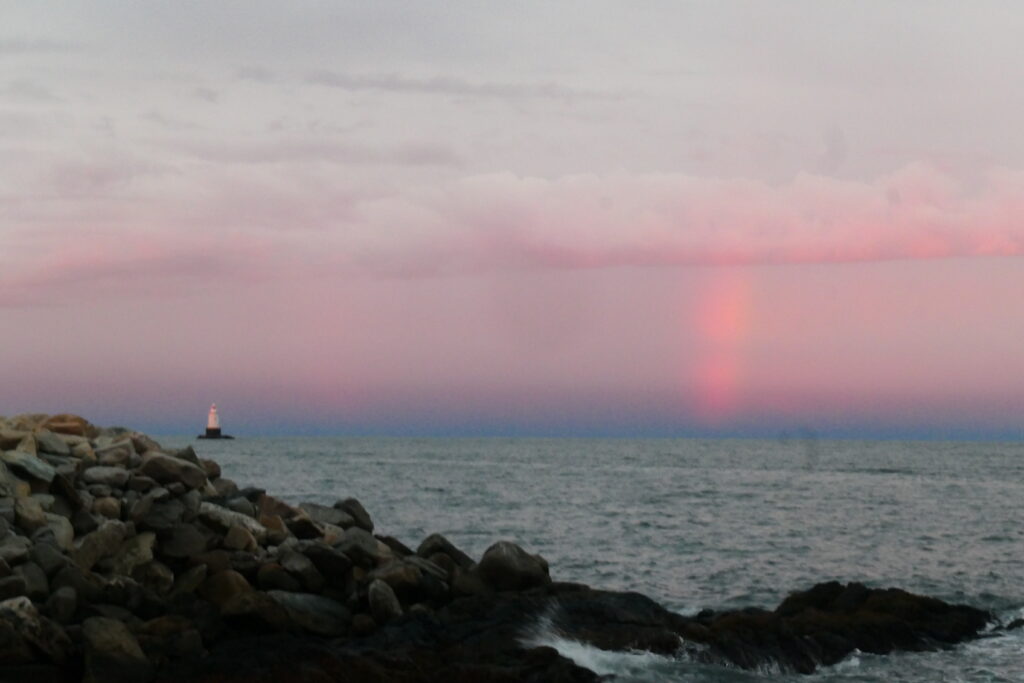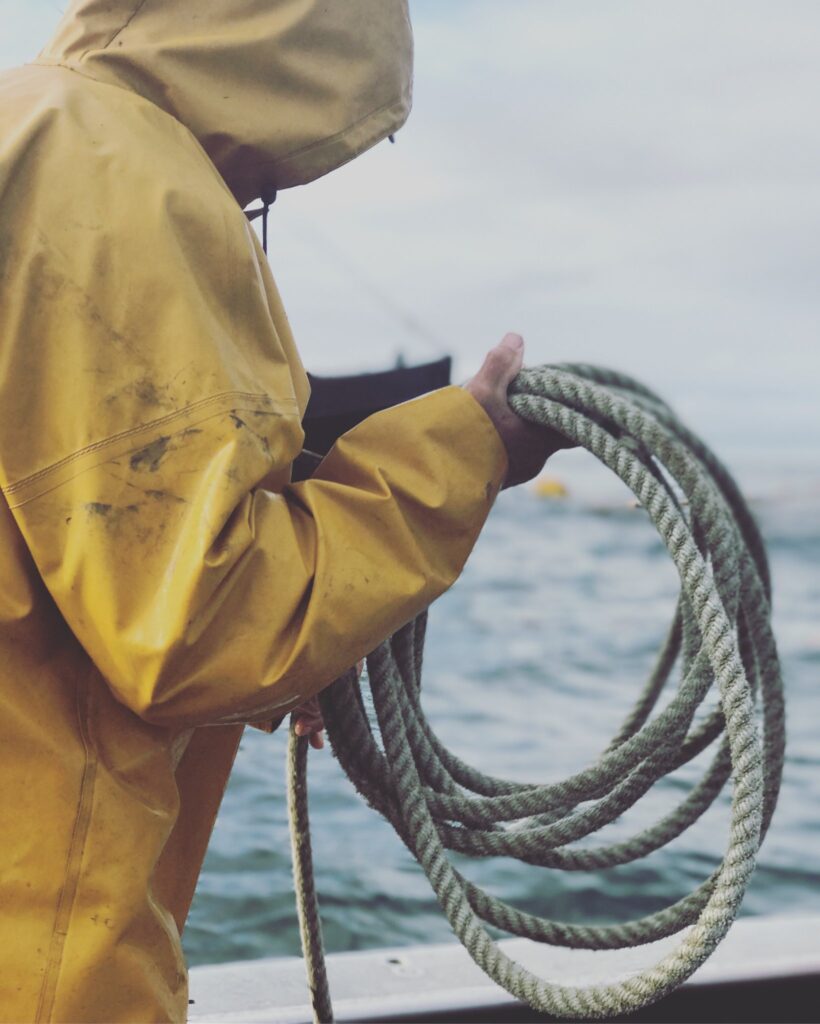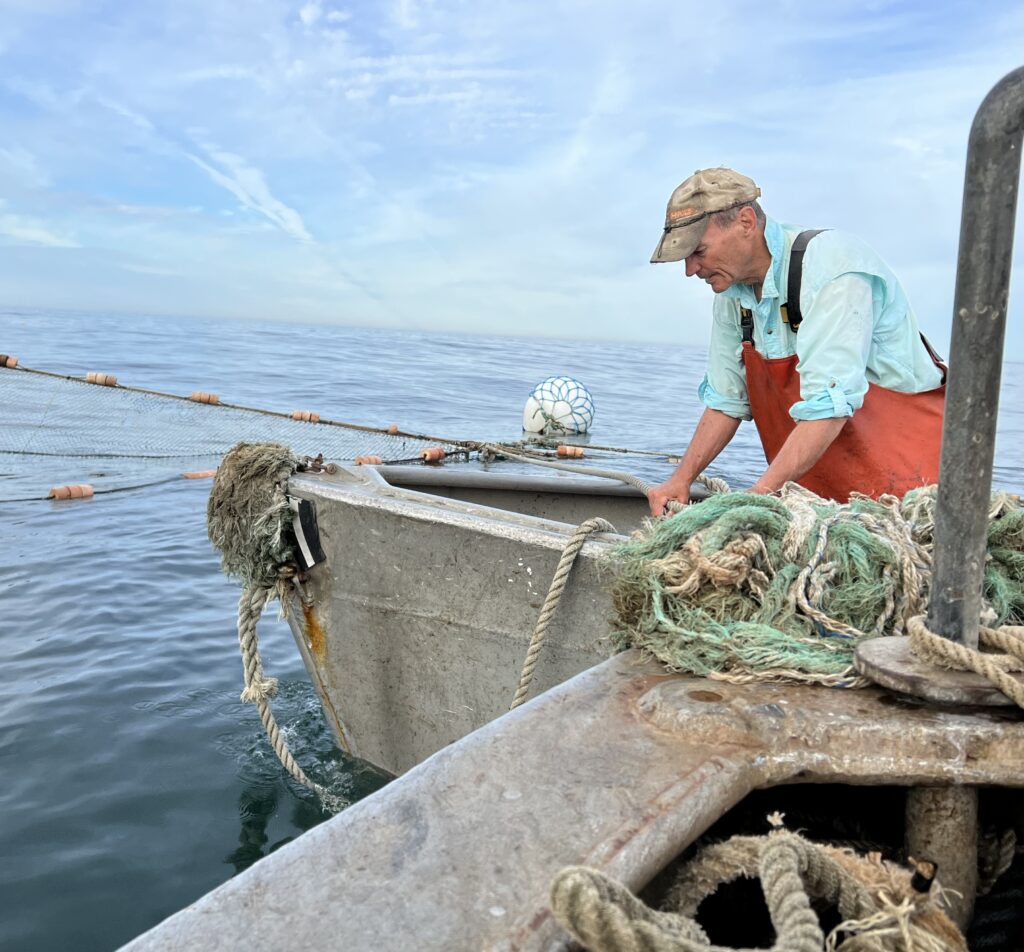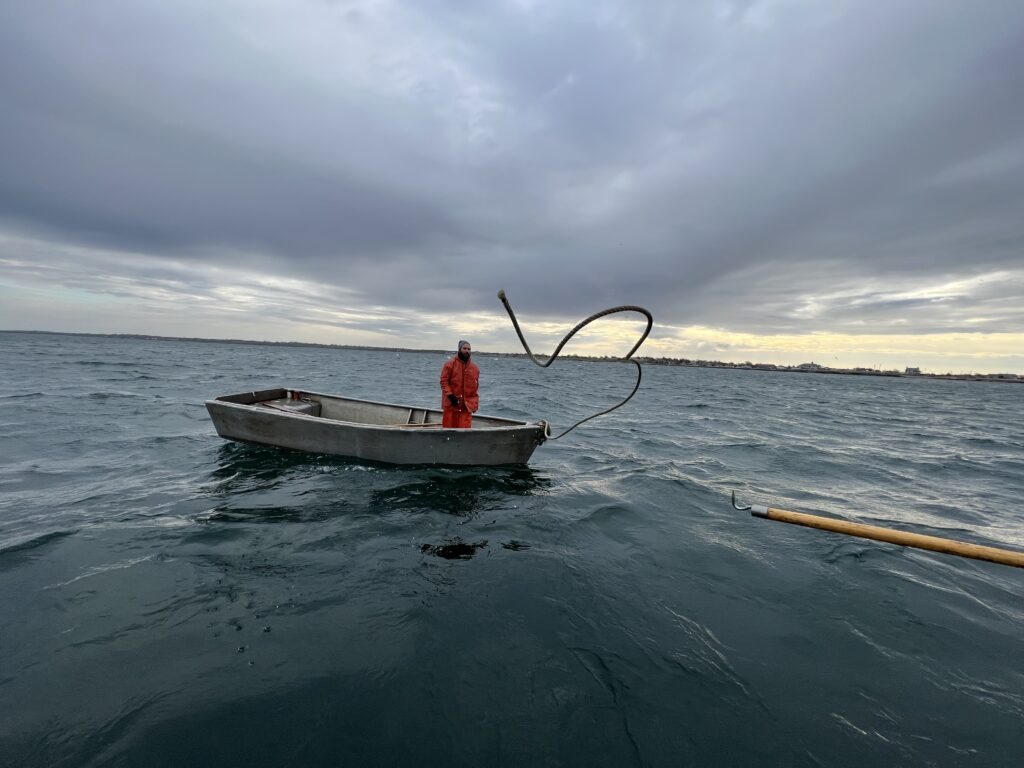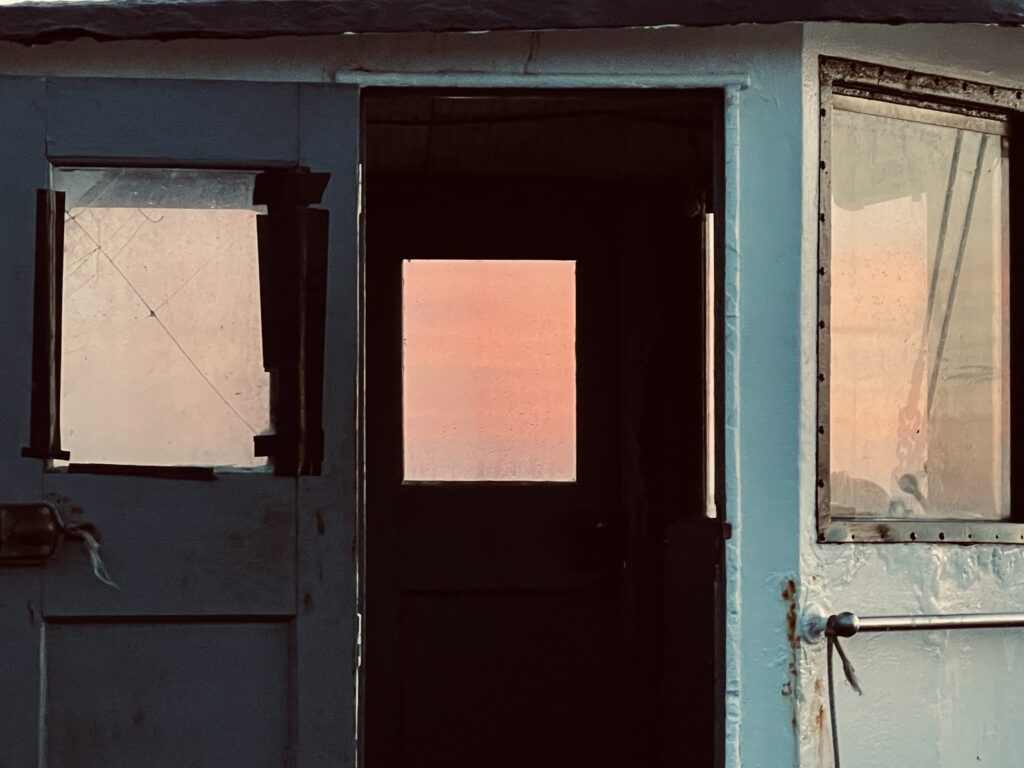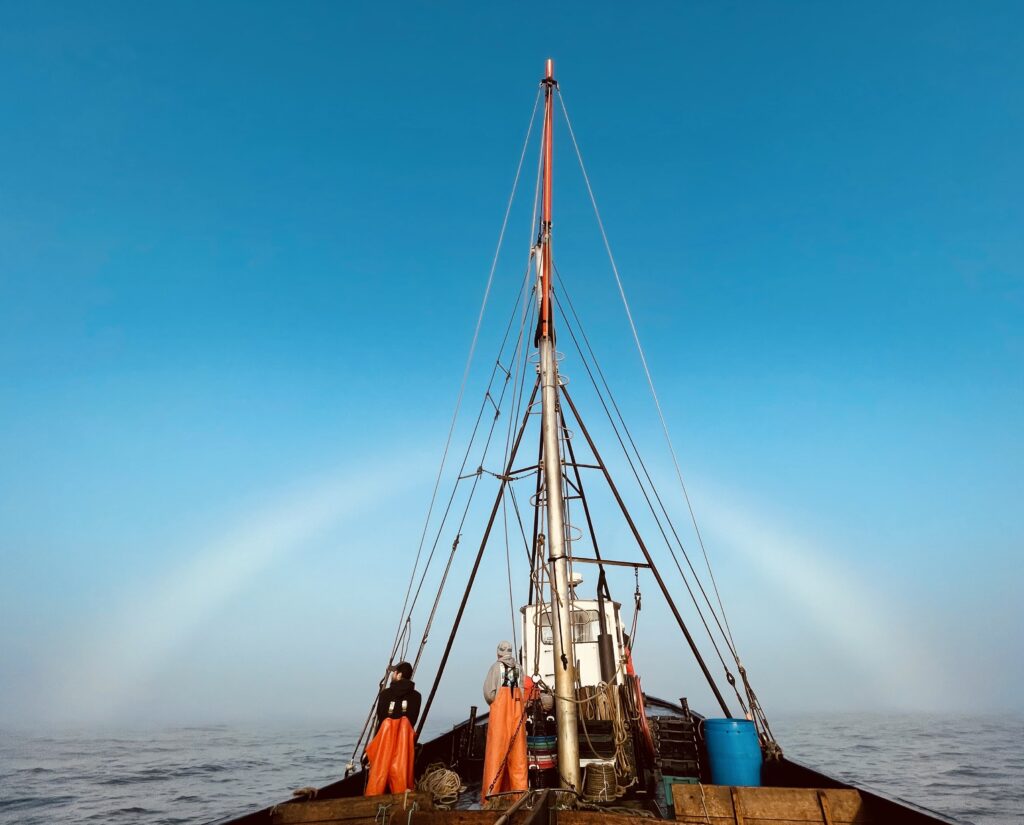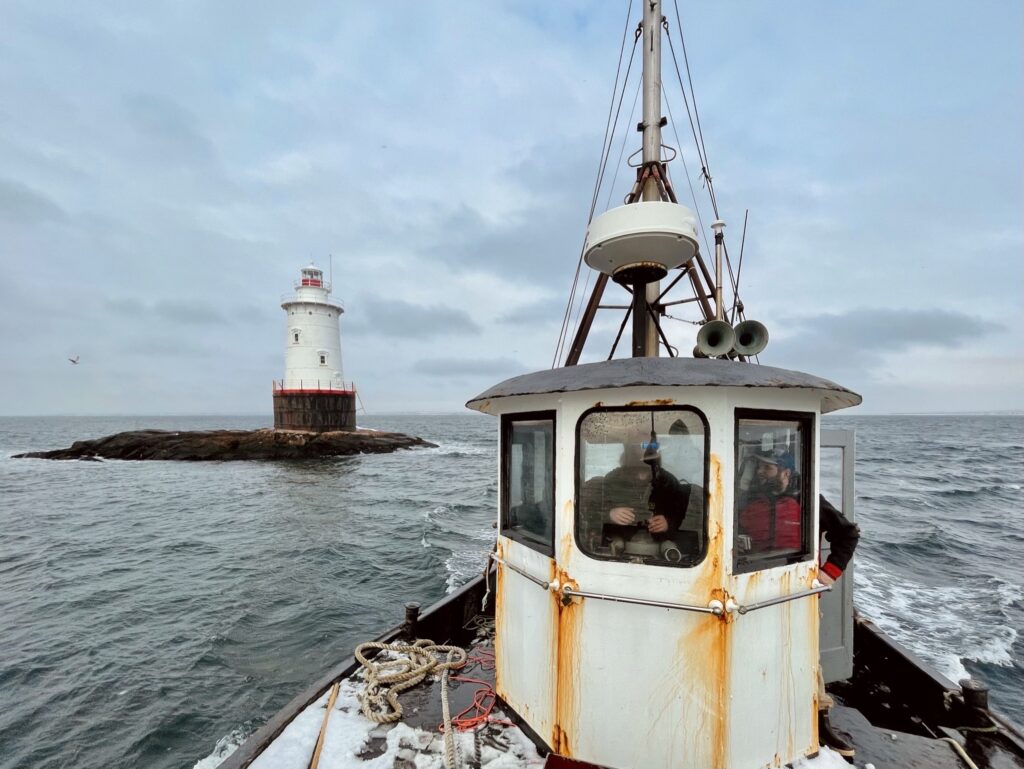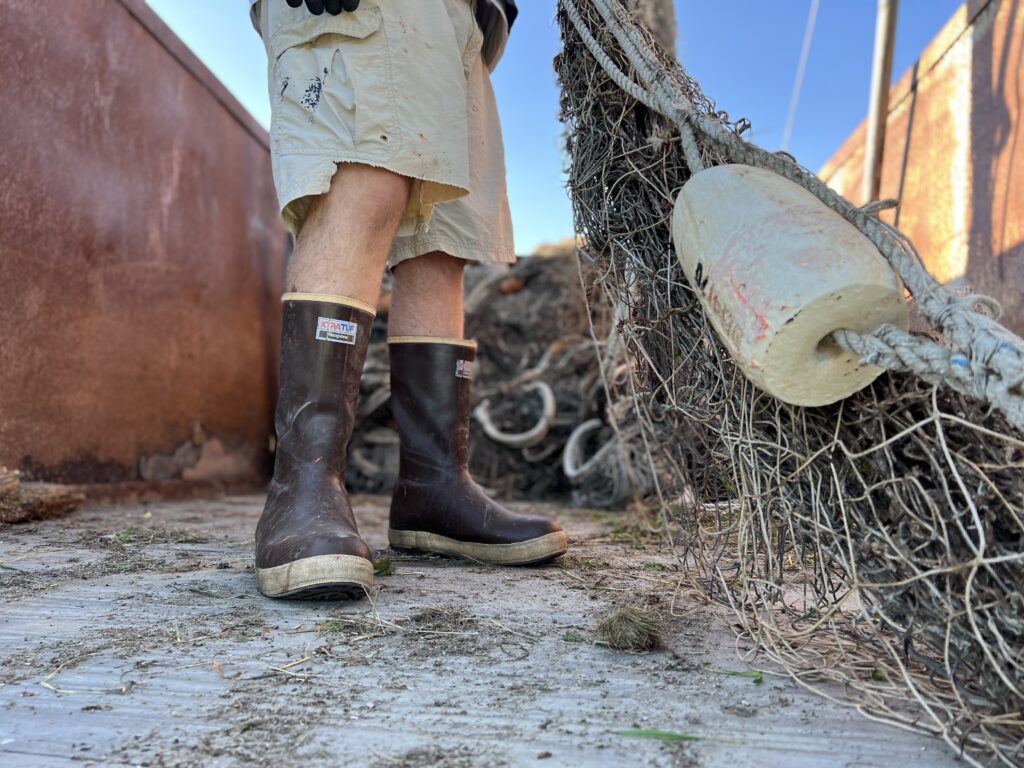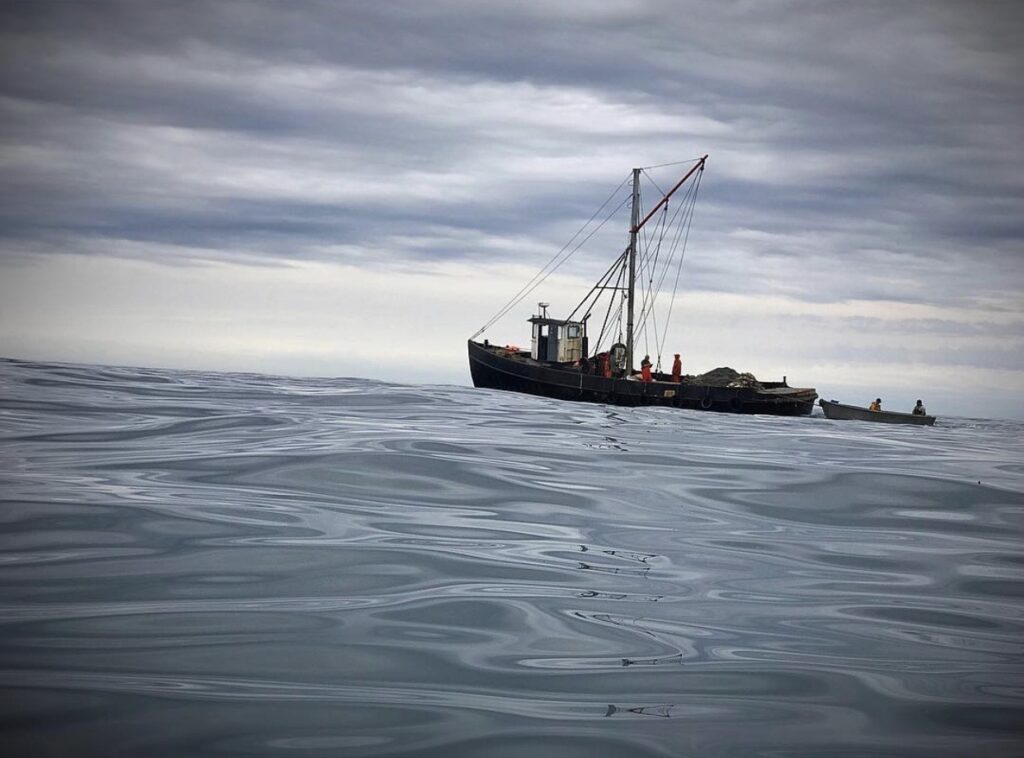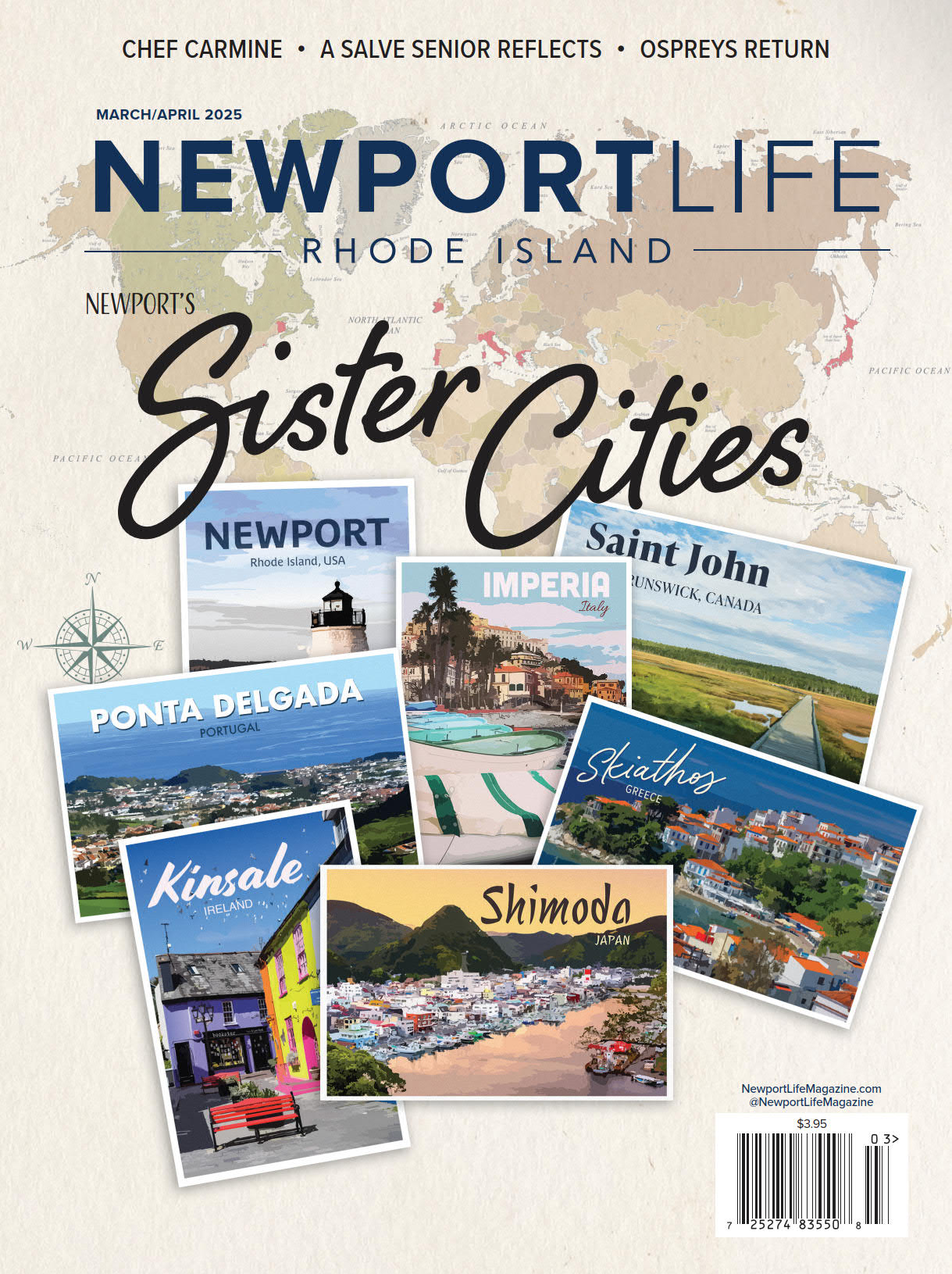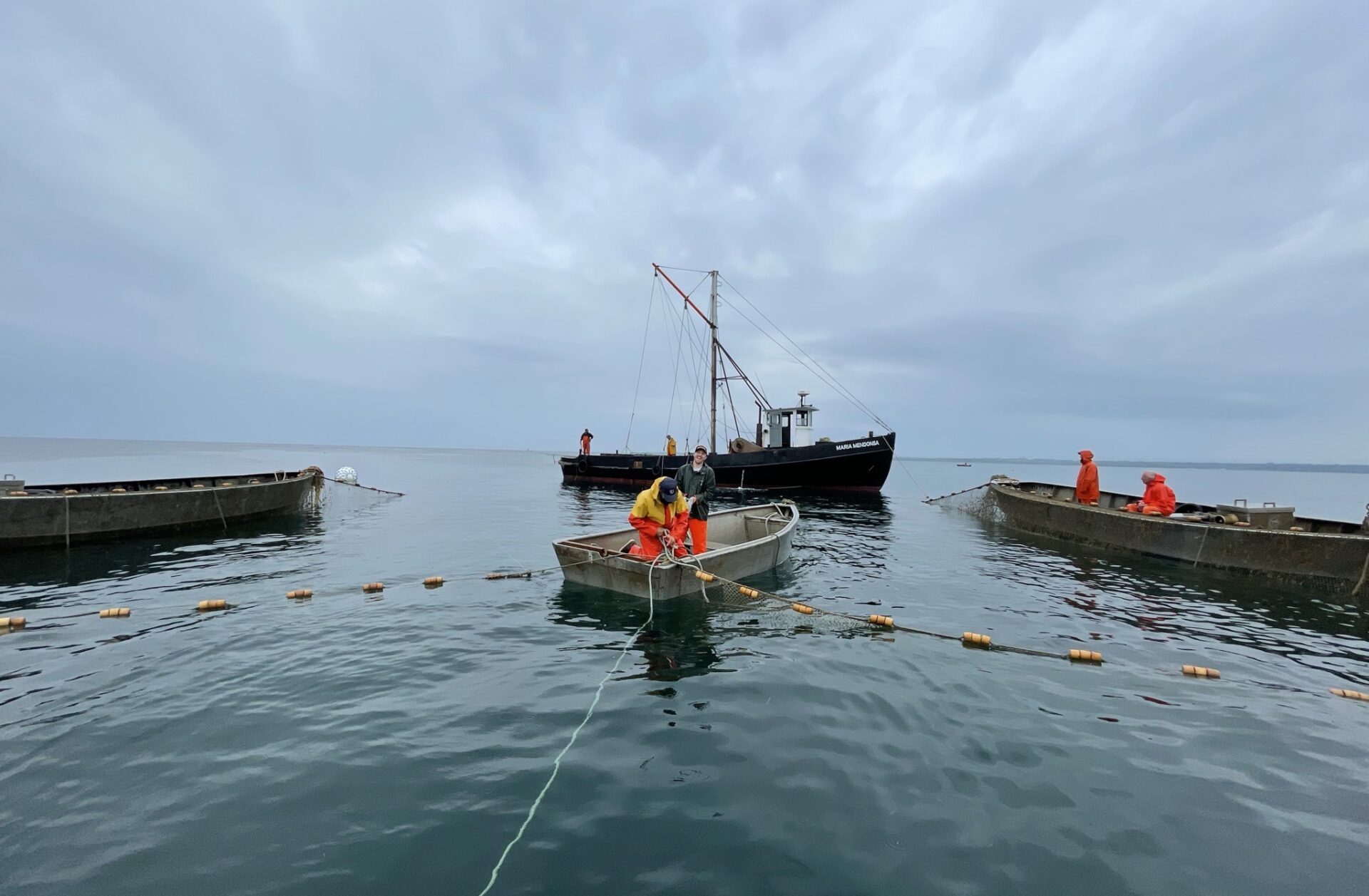The last of the trap fishers
By Andrea E. McHugh
Corey Wheeler Forrest is a third-generation Rhode Island trap fisherwoman, capturing real moments at sea, from the salty crew to the sunrise
Photos by Corey Wheeler Forrest
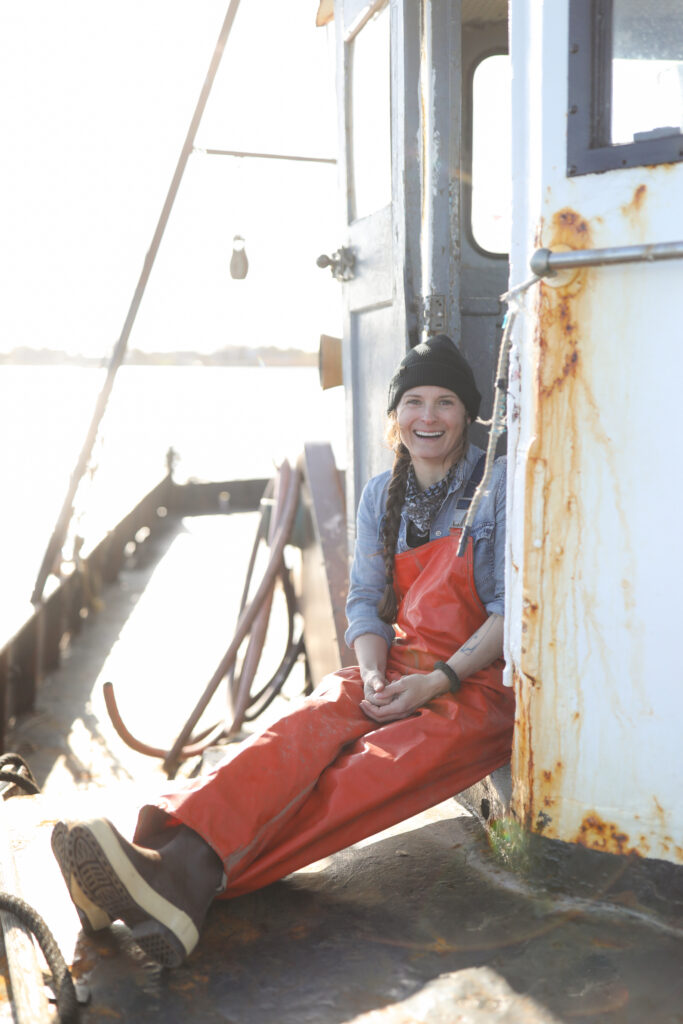
In the shadow of the Sakonnet Point Lighthouse, the M/V Maria Mendonsa sways rhythmically in the chop, where a veil of fog has blanketed this patch of the Atlantic and a cacophony of cawing gulls swirl overhead.
Clad in her unofficial uniform of bright orange fishing bibs and a sturdy pair of thick-soled deck boots, Corey Wheeler Forrest pulls up one fistful of net at a time — “hauling twine”— while steadying herself against the hull of a smaller boat. It’s another hardscrabble “day at the office” for this third-generation commercial fishermom and fishdealer. The work is undeniably brutal, but Forrest finds it is equally beautiful.
“I wouldn’t want to be anywhere else, even on the tough days,” she says. “When I am fishing out there, it is just so beautiful, but it is also so hard as well, so if I don’t stop and appreciate those moments of beauty, it would be a hard profession to stay in.”
In the 19th century, there were nearly 200 fish traps like Forrest’s peppered along Rhode Island’s coastline. Today, hers is one of the last trap fishing families in the business. “We don’t want to be the last ones,” Forrest says. “We want to keep this kind of fishery going, but it’s not easy.” Trap fishing is a laborious, low-tech, sustainable fishing methodology that Forrest says is not unlike the ways Native Americans used to catch migratory fish.
On a fishing day, The M/V Maria Mendonsa steams out — lingo leftover from the 19th century when the boats were steam powered — to the site trailed by a trio of 30-foot work boats and a skiff — looking like obedient ducklings in their mother’s wake.
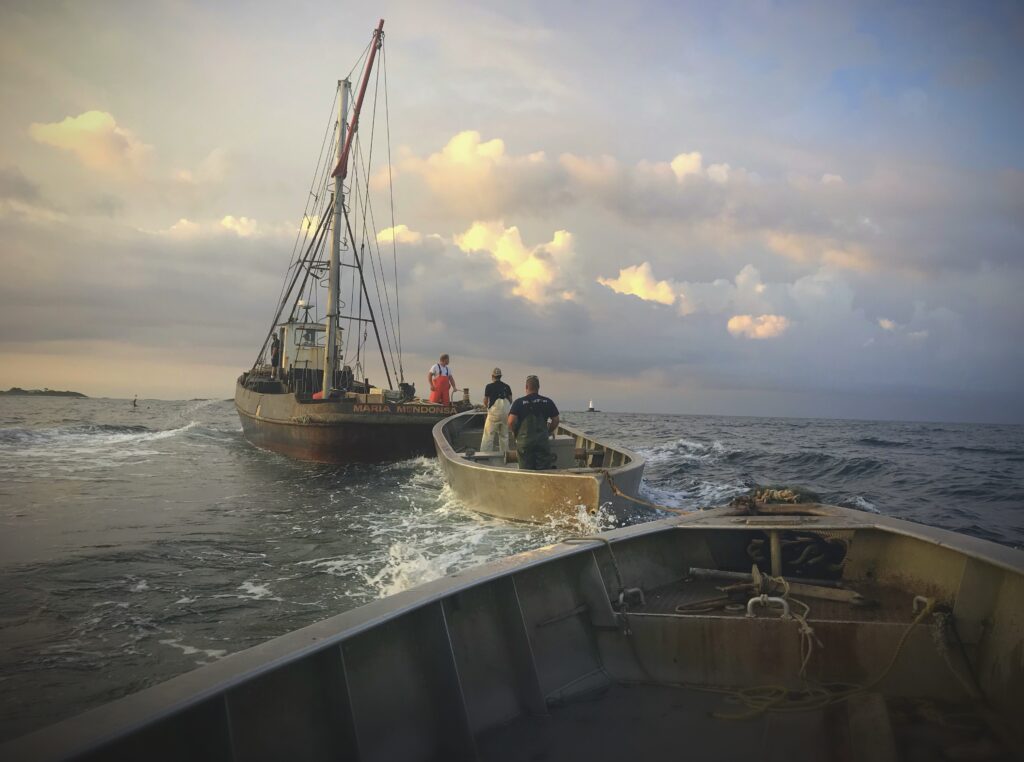
Once there, the main boat is tied to the head of the trap, and crews take to the smaller boats, rowing them into box-like positions. A quarter-mile long leader net has lured fish into the trap, which functions similarly to a lobster pot, as once the fish swim in, they can’t escape, only it’s massive — larger than a football field, held in place by twenty six 900-pound anchors.
“Then, hand over hand, we gather with the bottom rising, bringing the fish up to the surface,” Forrest says. “But what make sour fishery different from some other fisheries is that it is like a floating aquarium. Everything is alive, so when we catch anything over quota, we can throw stuff back overboard and they swim away.”
The same goes for the errant shark or stingray.
Forrest’s grandfather bought his first trap company in the 1940s, and inevitably, Forrest’s father, Alan, learned the ropes. In 1997, they purchased a trap company out of Newport owned by the late George Mendonsa, a legendary local fisherman who learned trap fishing from his father, a Portuguese immigrant. (It should be noted, he was also legendary for being identified as “The Kissing Sailor” from the iconic Life magazine cover photo of a sailor kissing a nurse in Times Square on V-J Day.)
The sale included the M/V Mendonsa, the 65-foot steel boat Forrest’s family runs today — named after Mendonsa’s mother — and the fishing site off Rough Point, the Gilded Age mansion at the south end of Bellevue Avenue once owned by Doris Duke, one of Newport’s most well-known summer residents.
“If it wasn’t for him—,” Forrest pauses. “He gave me such an opportunity as a woman. I don’t know, I think I was very lucky. I don’t think a lot of women get that opportunity.”
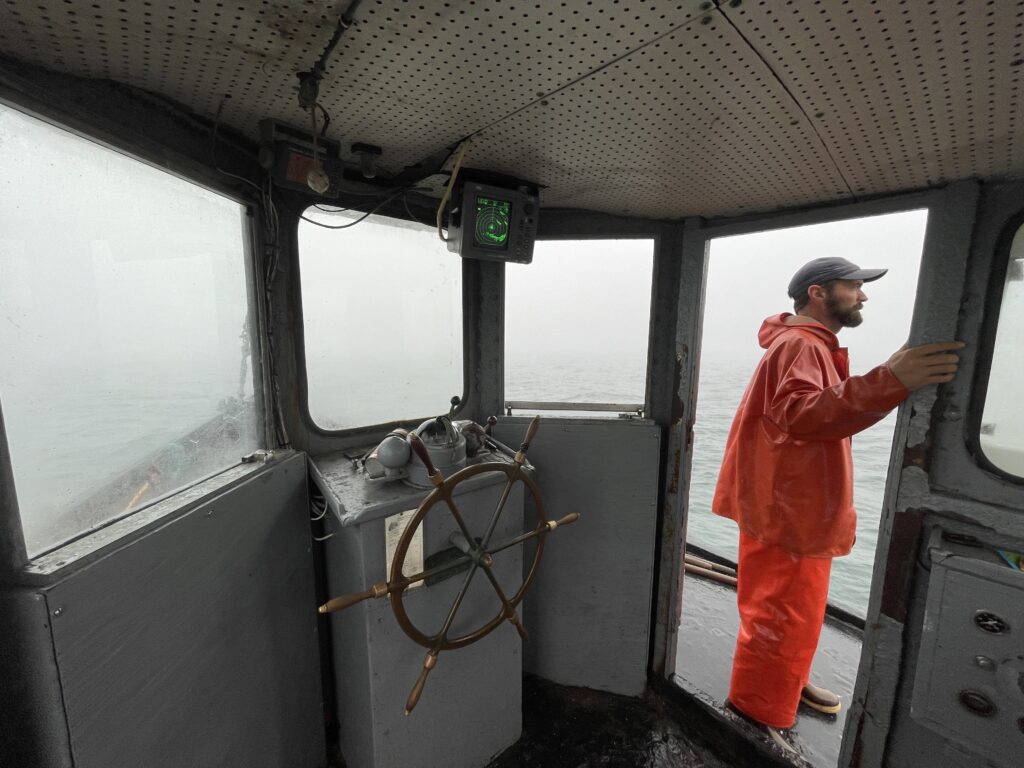
Even though trap fishing is her family business, it was George Mendonsa who took her under his wing.
“Almost like a grandfather would,” Forrest said. “He was amazing, and he was really respectful.
“When I first started going to the boats, he wouldn’t allow the guys to even swear in front of me, and that’s just part of fishing!” she laughs. “But that didn’t last long.”
When Forrest’s family bought Mendonsa’s company, they thought George would stick around for a year or so, as he just wasn’t ready to retire. “He ended up staying for 10, and he brought over two of his key crewmembers too, so I really learned from the best of the best,” Forrest says.
Mendonsa fished until he was 82 years old. He died in 2019, two days shy of his 96th birthday.
Growing up, Forrest hardly thought trap fishing would be her life’s work.
“When I was young, I walked down docks and there were never any women coming off the boats,” she recalls. She wrote in an essay about her experience:
The faces of fishing, as I recall, were a blue-collar gang of burly, brutish men, unkept in their oilskins, fish scales hanging from their beards, and cigarettes dangling from their mouths. There was unfiltered grumbling of men sorting, weighing, boxing and icing, as the fish were shoveled off the boat onto a conveyor belt. Most hadn’t had a day off in 40 days, were probably hungover, definitely in need of sleep, and completely indifferent about offending any passersby or fellow shipmates. This is why it took me nearly 20 years to step foot aboard my father’s fishing boats.
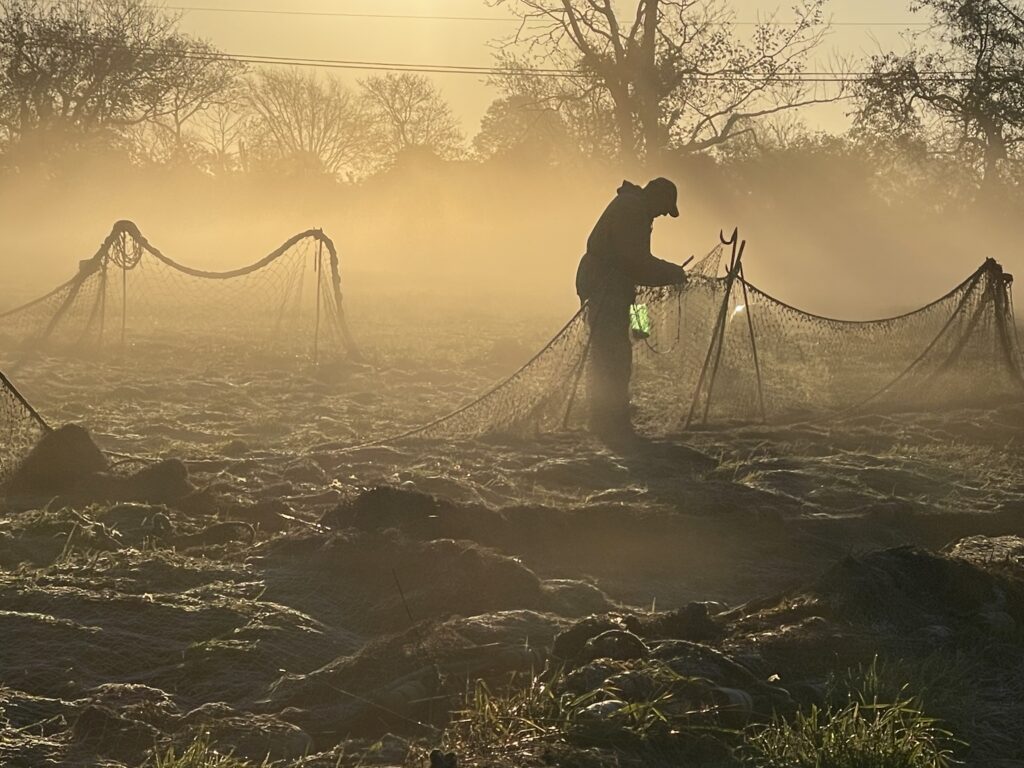
But while home from college one summer, Forrest didn’t have work lined up, so her father suggested she mend nets for him.
Seasoned men with calloused hands in their 70s and 80s taught her how to mend nets, all the while telling stories of days they’d spent fishing with her grandfather. These were the tales only lifelong watermen can tell.
Forrest was hooked.
The following summer, while she was mending nets on the docks, her father came to her when he was short a crewman. He couldn’t go out without another set of hands.
“I went out and it was just amazing,” Forrest says. “I couldn’t believe I waited so long.” From that moment on, she says she couldn’t stay away. “It just took over.”
This time of year, Forrest typically rises well before dawn — at 3:30 a.m. if she needs to make shipping boxes or 4 a.m. if she’s “sleeping in.” Her 30-minute drive from the family compound in Portsmouth to the commercial fishing dock at Sakonnet Point in Little Compton through mostly verdant countryside is sacrosanct.
It gives her time to sip her coffee and listen to music or an audiobook (she prefers the real thing in the off season) before the bustle of a 14-hour day ahead. As first light peeks over the horizon, the M/V Maria Mendonsa’s lines are tossed and the diesel engine’s lullaby invites a welcome catnap for the sleepy-eyed crew, if they’re lucky.
But not Forrest. This is when she captures the sheer beauty of it all.
Forrest started snapping photos on her iPhone while aboard to keep a visual diary of where, when, and what they were catching, what the weather was like and other data points. Then there were more images — a gull perched on a timeworn hull, symmetrically stacked rusty anchors against the backdrop of a bluebonnet sky, saltwater-bleached ropes alongside nets ready for mending sprawled on a field at magic hour.
“It’s hard to take a bad picture out there,” admits Forrest. “All the elements are there — the salty crew, the sunrise, the rust, and that sort of thing.”
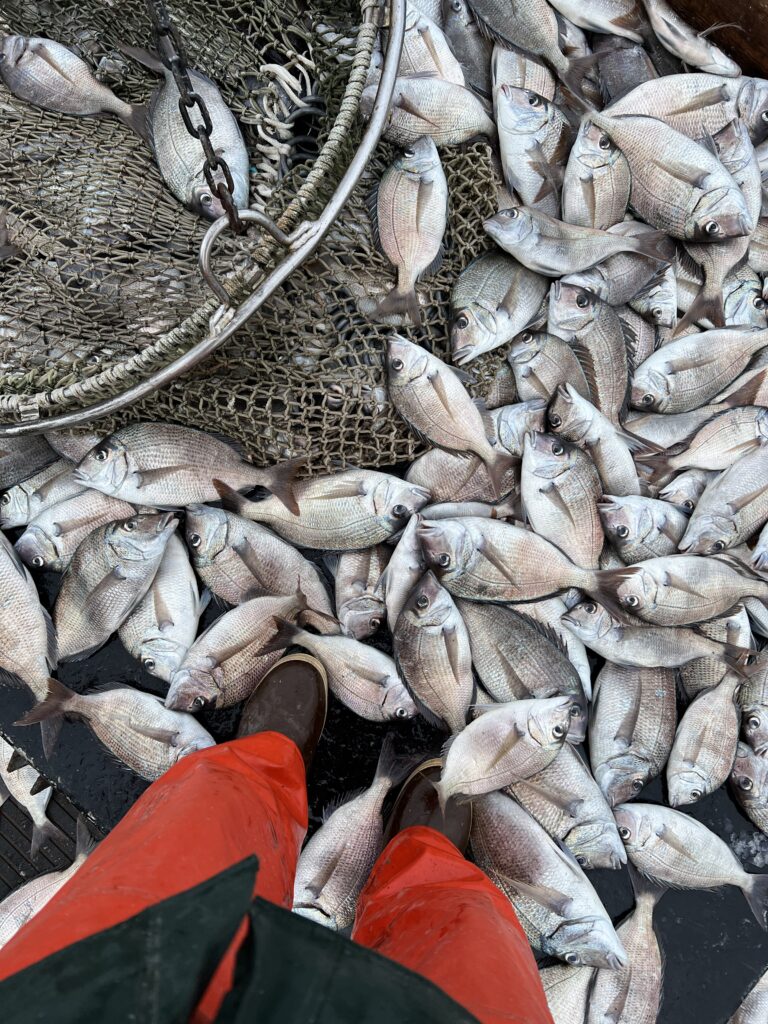
Mystic Seaport Museum in Connecticut took notice, and an exhibit of more than 30 of her images is on display at the Museum’s historic Meeting House through June 18, 2023. Forrest recently learned the exhibit will be touring thereafter (follow her work and the exhibit’s schedule on Instagram @fishandforrest).
Currently, this trap fishing crew is ankle-deep in scup, catching tens of thousands of pounds a day. The yield will grow smaller as summer unfolds, but the next round of fish — bluefish, striped bass, sea bass and fluke — have a higher price on their head.
Once they return to the dock, the fish are unloaded and meticulously packed in ice for shipping. Forrest has sold to buyers from Canada to South Carolina, but her biggest customer is the 200-year-old Fulton Fish Market in the Bronx (it moved from New York’s South Street Seaport in 2005). The 400,000-square-foot market handles up to two million pounds of fresh seafood every day, making it the second largest fish market in the world after Tokyo.
When Forrest arrives, she’s typically greeted with hugs — she is the fisherwoman from Rhode Island. “They definitely don’t hug each other, but I have a different relationship with them,” she laughs.
What are the chances for a fourth generation working the family fish trap?
Forrest’s daughter, 16, and son, 20, both have sea legs. Soon after they were both born, she strapped each one of them to her chest in a baby carrier when she was working down on the docks. But Forrest knows all too well that the saltwater life and trapfishing comes with uncertainty — the sea’s timeless poetry of great risk and hopefully great reward.
As for Forrest, she’s rolled up her sleeves, as she has for more than 20 summers, exposing her left forearm permanently emblazoned with artwork depicting Aquidneck Island and the Sakonnet Peninsula, marking the family fishing grounds — as if she’d ever not be able to find her way home.
A selection of images taken by Corey that were on exhibit in Mystic:
